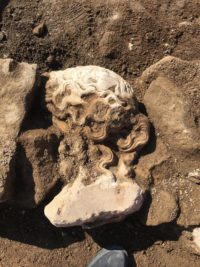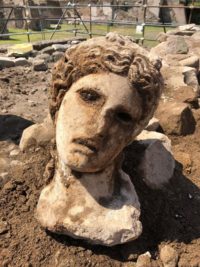 A beautiful larger-than-life white marble head of a statue from the Imperial era has been discovered in a late medieval wall. It was discovered Friday morning by archaeologists from the Capitoline Superintendence for Cultural Heritage excavating the Via Alessandrina, a 16th century road that runs between the Forums of Trajan, Augustus and Nerva. It was the main artery of the Alessandrino neighborhood, the first systematic urban renewal project in the area between the Forum of Nerva and Trajan’s Column. Beginning in 1570 at the behest of Cardinal Michele Bonelli, nephew of Pope Pius V, the site was reclaimed from water, scattered ancient remains and vegetation, raised and leveled for new construction. The road is all that remains of the neighborhood now. It was demolished between 1930 and 1933 to make way for the construction of what would become Via dei Fori Imperiali.
A beautiful larger-than-life white marble head of a statue from the Imperial era has been discovered in a late medieval wall. It was discovered Friday morning by archaeologists from the Capitoline Superintendence for Cultural Heritage excavating the Via Alessandrina, a 16th century road that runs between the Forums of Trajan, Augustus and Nerva. It was the main artery of the Alessandrino neighborhood, the first systematic urban renewal project in the area between the Forum of Nerva and Trajan’s Column. Beginning in 1570 at the behest of Cardinal Michele Bonelli, nephew of Pope Pius V, the site was reclaimed from water, scattered ancient remains and vegetation, raised and leveled for new construction. The road is all that remains of the neighborhood now. It was demolished between 1930 and 1933 to make way for the construction of what would become Via dei Fori Imperiali.
Archaeologists were excavating a wall from the early days of the Alessandrino neighborhood, dozens of feet above the ancient layers of the city, when they found the head of the statue face down in the wall. The head had been recycled by the medieval builders and plugged into the wall like a regular block of stone. The masons didn’t even attempt to make it more block-like, thankfully, and it’s in very good condition, despite its detachment from its body long ago, its stint as another brick in the wall above ground and below.
 The head bears a resemblance to the Ephesus group of Amazons carved in the 5th century B.C. by the greatest artists of the Classical period (Phidias, Polyclitus, Kresilas) and widely copied for the gardens and homes of the Roman elite. (Here’s one example in the Capitoline.) However, archaeologists believe it’s a representation of Dionysos who was often depicted as an androgynous youth. The figure wears a diadem of ivy leaves adorned with an ivy bloom, a characteristic Dionysian attribute, tying back the long, thick, wavy hair. The mouth is parted, the visage benevolent and unlined. The eye sockets are hollow now, but originally would have held eyes of glass or gemstone. That style of eye is typical of the first two centuries of the empire.
The head bears a resemblance to the Ephesus group of Amazons carved in the 5th century B.C. by the greatest artists of the Classical period (Phidias, Polyclitus, Kresilas) and widely copied for the gardens and homes of the Roman elite. (Here’s one example in the Capitoline.) However, archaeologists believe it’s a representation of Dionysos who was often depicted as an androgynous youth. The figure wears a diadem of ivy leaves adorned with an ivy bloom, a characteristic Dionysian attribute, tying back the long, thick, wavy hair. The mouth is parted, the visage benevolent and unlined. The eye sockets are hollow now, but originally would have held eyes of glass or gemstone. That style of eye is typical of the first two centuries of the empire.
The sculpture has been transported to the Imperial Forums Museum where the remaining soil will be removed and the head conserved before being put on public display.
You can see how it was placed in the wall in this cool video of its discovery.
Always use your head when you’re building a wall.
or… when they say walls have ears, it was true in this case.
😉